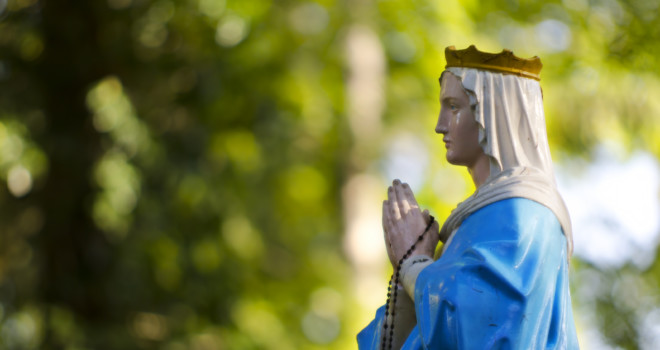
 Something happens to Mary over the course of the gospels.
Something happens to Mary over the course of the gospels.
She seems to fade away.
When we first meet Mary, she is at the center of the story. She is ‘full of grace’—so holy and honored that even the archangel kneels before her. In the Old Testament, God’s cloud of fire settled on Mt. Sinai. But now the power of His presence comes upon Mary. God rests hidden within her womb.
In the infancy narratives, Mary remains a major character in the story. The story is told from her perspective. When the shepherds come to adore the infant Jesus, it is she who ponders what their visit might mean. It is Mary who is told by Simeon that she will suffer with Jesus. And when His parents lose Him and search for Him, it is Mary who asks why Jesus had remained behind.
But then, during Jesus ministry, Mary’s role seems to change.
It starts at the wedding at Cana in John 2. The story begins with Mary in foreground: “On the third day there was a wedding in Cana in Galilee, and the mother of Jesus was there” (verse 1). The attendance list begins with Mary. Only in the second verse is it mentioned that Jesus and His disciples were there as well—almost as a kind of afterthought.
When the party runs out of wine, it is Mary who first steps in and becomes aware of the need. She then asks Jesus to intervene. In responding to her, Jesus affirms she has a role in the dispensation of His grace, while also clarifying that their roles are distinct. He does not say ‘What would you have with me?’—as some translations erroneously have it. Nor does He say ‘What has this to do with us?’ Instead He says: ‘Woman, what is that to me and to thee?’
Mary does not directly respond. Instead, she steps back from the scene, telling the servers to “Do whatever he tells you” (verse 5). Those are her last words in the gospels. From then on it is Jesus, the Word of God, who speaks.
At two subsequent points in Jesus’ ministry, He appears to distance Himself from His mother. One moment—that is recorded in all three Synoptic gospels—occurs when Jesus is informed that His mother and other relatives had come looking for Him. (Although some translations identify those relatives as brothers, they are best understood as cousins.) Here is how He answers them, according to the version in Mark:
But He said to them in reply, “Who are my mother and my brothers?”
And looking around at those seated in the circle he said, “Here are my mother and My brothers. For whoever does the will of God is My brother and sister and mother.” (Mark 3:33-35).
One other similar exchange is in Luke:
While he was speaking, a woman from the crowd called out and said to him, “Blessed is the womb that carried you and the breasts at which you nursed.” He replied, “Rather, blessed are those who hear the word of God and observe it.” (Luke 11:27-28).
Such distancing seems to reach its climax on the cross, when Christ finally acknowledges the severing of His temporal ties with Mary by handing her over to John. (See John 19.)
Taken on their face, these verses could be construed as supportive of a Protestant anti-Marian interpretation. But there is much more happening here beneath the surface.
In the first place, Mary’s apparent demotion cannot be fully reconciled with her earlier prominence. It would not make sense for God to prop her up only to tear her down so. Nor does it make sense on the level of nature to simply see in Jesus’ actions a rejection of His mother. The crucifixion scene particularly argues against this viewpoint because it is precisely in entrusting her to the care of another that Jesus’ deep love for His mother is evident.
Another way of reading these passages is through the lens of Cana, where Mary stands at the fore, intercedes for us with Jesus, and then steps back. In a sense, this could be happening on the broader scale of the entire gospel narrative: in the beginning, Mary cooperates with God’s plan for redemption, bringing Jesus to the world. She spends the rest of the gospels doing everything she can to place Jesus at the center—even if that entails an apparent diminishment of her identity as a biological mother.
In a way, Mary’s declining visibility mirrors John the Baptist who likewise recognized that Jesus ‘must increase’ as he ‘must decrease.’ (This is spoken in John 3:30, the chapter after the wedding at Cana.)
In other words, Mary’s decreasing role isn’t about minimizing her at all. It’s about maximizing Jesus.
But there’s a second dynamic also at work in Mary’s journey through the gospels: even as her biological tie to Jesus as His birth mother is de-emphasized, her spiritual motherhood is accentuated.
This is indicated in those times in Jesus ministry when He appears to reject all familial bonds. Catholic interpreters understand His two statements—‘For whoever does the will of God is my … mother’ and ‘Blessed are those who hear the word of God and observe it’—as affirmations of Mary. For Mary is the one who submitted to the will of God in accepting the Incarnate Word in her womb. And Mary is ‘blessed’ because she heard the words of God passed on through the angel and accepted them.
Again, this favorable reading of these two stories is much easier to reconcile with the beginning of the gospels than the Protestant interpretation.
And it is confirmed with the form of address Jesus uses for His mother in John 2 and 19—‘woman.’ To call Mary ‘woman’ might distance her from Jesus in biological terms, but it also expands her reach. It universalizes her in a way similar to how Jesus Himself is cast in the gospels as the universal man through the title ‘Son of Man.’
As universal man and universal woman, Jesus and Mary become the new Adam and the new Eve. Indeed, in Genesis, Adam employs similar language in describing himself and Eve:
The man said:
“This one, at last, is bone of my bones
and flesh of my flesh;
This one shall be called ‘woman,’
for out of man this one has been taken” (Genesis 2:23).
Jesus as Adam and Eve served as the template upon which the rest of humanity was based, so also now Jesus and Mary are the new molds out of which mankind will be recast and redeemed. The title ‘woman’ looks forward to the pinnacle of redeemed humanity in heaven—which is Mary enthroned as Queen. Christians are granted a glimpse of this in Revelation 12, where Mary is described in seemingly impersonal terms as ‘woman’:
A great sign appeared in the sky, a woman clothed with the sun, with the moon under her feet, and on her head a crown of twelve stars (Revelation 12:1).
Mary’s motherhood has been stretched out in time and space: all of humanity now falls under her protection—not just during her earthly life, but throughout the course of all history. In a way, her loving ‘motherhood’ has been stretching outwards. All of history is contained within her story. As Bishop Fulton Sheen wrote in The World’s First Love, Mary is the mother par excellence:
A wife is essentially a creature of time, for even while she lives she can become a widow; but a mother is outside time. She dies, but she is still a mother. She is the image of the eternal in time, the shadow of the infinite on the finite. Centuries and civilizations dissolve, but the mother is the giver of life. Man works on this generation: a mother on the next. A man uses his life; a mother renews it (184).
Perhaps this is one reason that God chose to make the new Adam and new Eve son and mother rather than husband and wife, like the first two. He wanted the work of His redemption to be lasting. It is true that on the cross Jesus gave up His earthly mother. But, in so doing, He gave us a mother for all time.










